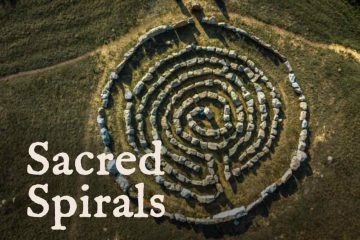Merry meet!
Thank you once again to all those who joined in last week’s Weekly Witchy Challenge - Wiccan Magick ![]()
Our exploration through pagan paths has come to an end, but the adventure continues. This week, feel free to spread your wings and look far - or give some love to some special places close to home ![]()
The theme for this week’s challenge was suggested by the lovely @stavroula and is…

![]()
![]() Sacred Places & Sacred Spaces
Sacred Places & Sacred Spaces ![]()
![]()
What places are significant to your practice?
While a large part of developing a magickal practice and forming your religious/spiritual beliefs happens within, we can’t forget about the significant outside influences that also give a home to your Craft.
Sacred places may be human-made locations, such as shrines, temples, churches, or historical or religious sites ![]() . They might also be natural places, such as forests, mountains, oceans, parks, etc
. They might also be natural places, such as forests, mountains, oceans, parks, etc ![]()
Sacred spaces may be smaller locations closer to home - they might be your altar, a ritual room, Craft corner, travel altar, etc ![]()
Whichever place(s) hold special important to your Craft, it’s time to give them some love and acknowledgment!
~ * ~ * ~ * ~ * ~ * ~ * ~ * ~ * ~
This week’s challenge is all about sacred places and spaces - but as always, how you do so is up to you!
So are you ready? Because it’s…
CHALLENGE TIME!
![]()
Stonehenge picture from Canva
STEP 1 : Close or Far: Special Places in Your Craft 
This challenge is all about sacred places and spaces - but how you choose to take on this theme is up to you!
Still not sure where to begin? To help you get started, here are a few ways in which a witch might approach this challenge…
Please make sure you are logged into your Spells8 Account so you can view all of the resources shared!
From churches to temples, shrines to forests - there are many sacred locations around the world. This week, consider your unique practice:
-
If you follow a tradition (be it Greek, Egyptian, Norse, Wiccan, etc), what sites or locations are sacred to your path?
-
If you worship a deity, do they have any special monuments or sites special to Them and Their stories?
-
If you are eclectic or unlabeled, are there any places that call to you spiritually?
Related discussions:
- Stonehenge: History of Magick
- Celebrate the Solstice with Stonehenge...or Foamhenge!
- Mên-an-Tol 🪨 Cornish Sacred Site
- St. Brigid’s Temple in Ireland
- Labyrinth experience
- https://forum.spells8.com/t/portals-or-gateways/37053
- Communing With Loki & Building Him a Temple
- Has anyone gone to a Witchy Historical place yet?

Egypt Photo by @Cosmic_Curiosity, shared in Egyptian Cat Deities
~ ~ ~ ~ ~ ~ ~ ~ ~ ~ ~ ~ ~ ~ ~ ~ ~ ~ ~ ~ ~ ~ ~ ~ ~ ~ ~
Sacred Spaces 
Regardless of spiritual or religious practice, many people have a designated place for their worship and/or practice. This may be a formal altar, ritual room, travel altar, or even a special spot where you keep your magickal tools or books.

Creating a Moon Altar: Making Offerings by Moonlight
Related discussions and resources:
- Making your Inner Temple: Casting Without Tools
- Creating a gratitude shrine
- All Altars - Share Yours with the Coven
The suggestions above are just a few ideas to help kickstart your creativity- if you feel called to explore sacred places and spaces in another way, you are welcome to do so!
As always, all witches are encouraged to embrace their own unique practice with how they explore the challenge theme ![]()
STEP 2 : Share Your Experience 
Click here for a note about challenge inclusivity
Everyone is welcome to join the challenge by practicing magick in line with the current theme. For lurkers and those who don’t feel comfortable sharing, it is absolutely okay to follow along with the challenge but keep your entry personal. Feel free to join in spirit and do what feels most comfortable for you! ![]()
That being said, please know that if you would like to receive a prize and a public shout-out, it is required that you share your experience.
Getting Your Credit 
In order for your entry to be counted, all you have to do is write/share about your experience and label it as your challenge entry. There is a lot of chatting here (which is awesome- chatting and discussion are very welcome!) so please clearly write that it is your entry so I know to count it! ![]()
Where Should I Share My Entry? 
Click here to learn where to share your challenge entry
You are welcome to post it right here- just click “reply” ![]() to this post and write your experience in the text box that pops up!
to this post and write your experience in the text box that pops up!
Alternatively, you could create a new post in the forum (this is good for when you have a lot to share and/or would like to discuss aspects of your entry not related to the current theme)
Note : If you do choose to create a new thread, please add the “challenge-entry” tag and/or add a hyperlink back to this post so that it can be easily found- thank you! ![]()
Deadline 
 This challenge will close in 6 DAYS
This challenge will close in 6 DAYS 
To join in, please share your experience by:
Tuesday, July 2 at 7:00 AM EDT (Eastern US Time)
2024-07-02T11:00:00Z
(Note that the time zone is ET- if you don’t see your time displayed above, you can use this time zone calculator to check for your time zone!)
Prizes 
For their efforts, all participants will receive a special shout-out and a small prize! ![]()
Acknowledgments will be given in a Props and Presents Post that will appear in the forums on Tuesday.
After the challenge closes, you are still very welcome to post but please be aware that no additional prizes will be given. This discussion will remain open for about a week after the challenge finishes.
A warm reminder that the challenges are designed to be very open- everyone is encouraged to participate in a way that honors and reflects their unique practice ![]()
If you have any doubts about if something is acceptable to post or say, please double-check with the Forum FAQ and/or reach out to your friendly Moderator Team.
And for those new to challenges- welcome! ![]() Know that the goal of these activities is to help you further diversify and strengthen your abilities and to bring together the Spells8 forum family to inspire and support one another in creative ways
Know that the goal of these activities is to help you further diversify and strengthen your abilities and to bring together the Spells8 forum family to inspire and support one another in creative ways ![]()
Temple of Poseidon picture by @stavroula, shared in Skies
~ * ~ * ~ * ~ * ~ * ~
Sacred places near or far
Reached by dreams, by plane, by car
A forest shrine or mountain peak
Temples Egyptian, Norse, or Greek
The sites await where you may roam-
In sacred places, you’ll always be home
~ * ~ * ~ * ~ * ~ * ~
Blessed Be! ![]()
![]()







































